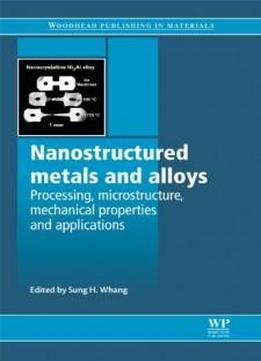
Nanostructured Metals And Alloys: Processing, Microstructure, Mechanical Properties And Applications
by Sung H. Whang /
2011 / English / PDF
27.9 MB Download
Tensile strength, fatigue strength and ductility are important properties of nanostructured metallic materials, which make them suitable for use in applications where strength or strength-to-weight ratios are important.
Tensile strength, fatigue strength and ductility are important properties of nanostructured metallic materials, which make them suitable for use in applications where strength or strength-to-weight ratios are important.Nanostructured metals and alloys
Nanostructured metals and alloys reviews the latest technologies used for production of these materials, as well as recent advances in research into their structure and mechanical properties.
reviews the latest technologies used for production of these materials, as well as recent advances in research into their structure and mechanical properties. One of the most important issues facing nanostructured metals and alloys is how to produce them. Part 1 describes the different methods used to process bulk nanostructured metals and alloys, including chapters on severe plastic deformation, mechanical alloying and electrodeposition among others. Part 2 concentrates on the microstructure and properties of nanostructured metals, with chapters studying deformation structures such as twins, microstructure of ferrous alloys by equal channel angular processing, and characteristic structures of nanostructured metals prepared by plastic deformation. In part 3, the mechanical properties of nanostructured metals and alloys are discussed, with chapters on such topics as strengthening mechanisms, nanostructured metals based on molecular dynamics computer simulations, and surface deformation. Part 4 focuses on existing and developing applications of nanostructured metals and alloys, covering topics such as nanostructured steel for automotives, steel sheet and nanostructured coatings by spraying.
One of the most important issues facing nanostructured metals and alloys is how to produce them. Part 1 describes the different methods used to process bulk nanostructured metals and alloys, including chapters on severe plastic deformation, mechanical alloying and electrodeposition among others. Part 2 concentrates on the microstructure and properties of nanostructured metals, with chapters studying deformation structures such as twins, microstructure of ferrous alloys by equal channel angular processing, and characteristic structures of nanostructured metals prepared by plastic deformation. In part 3, the mechanical properties of nanostructured metals and alloys are discussed, with chapters on such topics as strengthening mechanisms, nanostructured metals based on molecular dynamics computer simulations, and surface deformation. Part 4 focuses on existing and developing applications of nanostructured metals and alloys, covering topics such as nanostructured steel for automotives, steel sheet and nanostructured coatings by spraying.











